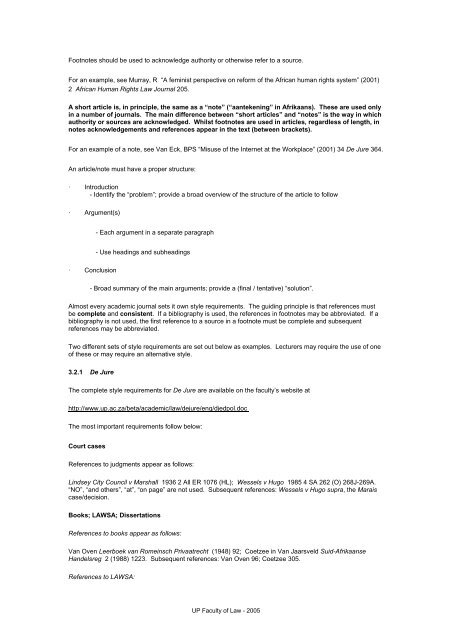o_19lfbhn471mmn1u3akhhp9p122ma.pdf
Create successful ePaper yourself
Turn your PDF publications into a flip-book with our unique Google optimized e-Paper software.
Footnotes should be used to acknowledge authority or otherwise refer to a source.<br />
For an example, see Murray, R “A feminist perspective on reform of the African human rights system” (2001)<br />
2 African Human Rights Law Journal 205.<br />
A short article is, in principle, the same as a “note” (“aantekening” in Afrikaans). These are used only<br />
in a number of journals. The main difference between “short articles” and “notes” is the way in which<br />
authority or sources are acknowledged. Whilst footnotes are used in articles, regardless of length, in<br />
notes acknowledgements and references appear in the text (between brackets).<br />
For an example of a note, see Van Eck, BPS “Misuse of the Internet at the Workplace” (2001) 34 De Jure 364.<br />
An article/note must have a proper structure:<br />
· Introduction<br />
- Identify the “problem”; provide a broad overview of the structure of the article to follow<br />
· Argument(s)<br />
- Each argument in a separate paragraph<br />
- Use headings and subheadings<br />
· Conclusion<br />
- Broad summary of the main arguments; provide a (final / tentative) “solution”.<br />
Almost every academic journal sets it own style requirements. The guiding principle is that references must<br />
be complete and consistent. If a bibliography is used, the references in footnotes may be abbreviated. If a<br />
bibliography is not used, the first reference to a source in a footnote must be complete and subsequent<br />
references may be abbreviated.<br />
Two different sets of style requirements are set out below as examples. Lecturers may require the use of one<br />
of these or may require an alternative style.<br />
3.2.1 De Jure<br />
The complete style requirements for De Jure are available on the faculty’s website at<br />
http://www.up.ac.za/beta/academic/law/dejure/eng/djedpol.doc<br />
The most important requirements follow below:<br />
Court cases<br />
References to judgments appear as follows:<br />
Lindsey City Council v Marshall 1936 2 All ER 1076 (HL); Wessels v Hugo 1985 4 SA 262 (O) 268J-269A.<br />
“NO”, “and others”, “at”, “on page” are not used. Subsequent references: Wessels v Hugo supra, the Marais<br />
case/decision.<br />
Books; LAWSA; Dissertations<br />
References to books appear as follows:<br />
Van Oven Leerboek van Romeinsch Privaatrecht (1948) 92; Coetzee in Van Jaarsveld Suid-Afrikaanse<br />
Handelsreg 2 (1988) 1223. Subsequent references: Van Oven 96; Coetzee 305.<br />
References to LAWSA:<br />
UP Faculty of Law - 2005


